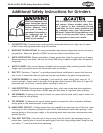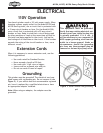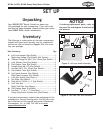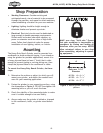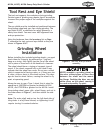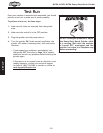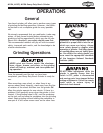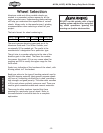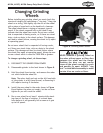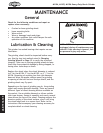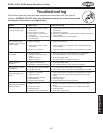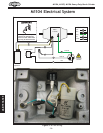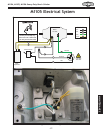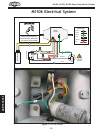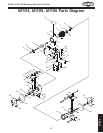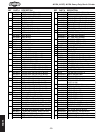
-13-
M1104, M1105, M1106 Heavy-Duty Bench Grinder
OPERATIONS
Changing Grinding
Wheels
Before installing any grinding wheel you must check the
structural integrity by performing a “ring test.” Hang the
wheel on a string, then lightly tap the rim of the wheel
with a piece of wood such as the handle of a hammer.
The wheel should have a ringing or harmonic type of
sound. If the wheel responds with a dull thud it may
indicate that the wheel has cracks. Do not use a wheel
that is suspected of having cracks, or if there are visual
chips, nicks or dents in the wheel surface. This damage
can lead to wheel failure, causing the wheel to fly apart
at operating speed.
Do not use a wheel that is suspected of having cracks,
or if there are visual chips, nicks or dents in the wheel
surface. This damage can lead to wheel failure where
the wheel flies apart at operating speed. Always be sure
to use a wheel which is rated for 3450 RPM or greater.
To change a grinding wheel, do these steps:
1. DISCONNECT THE GRINDER FROM POWER!
2. Disassemble grinder to the level shown in Figure 8.
3. Hold the wheel from turning, and remove the arbor
nut which holds the wheel on.
Note:
The arbor shaft and nut on the left hand side
of the grinder is a left hand thread, so loosening it
will require turning it clockwise.
4. Install the new wheel in the order shown in Figure
8 and tighten the arbor nut snugly, but do not over
tighten or you will crack the wheel.
5. Run a new wheel for at least 1 minute while stand-
ing clear of the line of rotation. If a wheel does
have defects it will generally fail as soon as it gets
up to full speed
.
Figure 8. Grinding wheel access.
NEVER assemble a grinding wheel on
the arbor without paper or fiber discs
between the wheel and the flange.
Omitting the discs can put uneven
stress on the wheel causing it to crack
and possibly fly apart. ALWAYS “ring
test” a wheel before assembly to make
certain it has no cracks or flaws.



